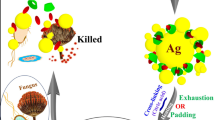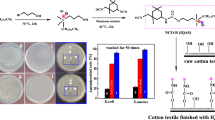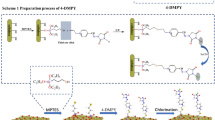Abstract
New antimicrobial textiles were prepared through direct chemical linkage of bioactive molecules eugenol and fluoroquinolone derivatives, onto the surface of cotton fabrics. The attachment through a triazine moiety minimizes the leaching of the antimicrobial molecule into the surroundings of the material. Bacterial efficacy against Staphylococcus aureus and Pseudomonas aeruginosa was studied. The treated textile with fluoroquinolone demonstrated bacteriostatic antimicrobial effects having a tendency to decrease the population of S. aureus in the planktonic form. A significant effect was also observed in the prevention of S. aureus biofilm formation and in its ability to kill bacteria within a preformed biofilm. Eugenol-modified fabric was also active in the process of eradicating preformed P. aeruginosa biofilms. Further, in vitro assays using human dermal fibroblast cells indicate no effects on cell proliferation and viability, and in vivo tests in a murine skin wound model showed no increase of IL-6 for full-thickness wounds that were in contact with the fabrics.
Graphic abstract









Similar content being viewed by others
References
Abramiuc D, Ciobanu L, Muresan R, Chiosac M, Muresan A (2013) Antibacterial finishing of cotton fabrics using biologically active natural compounds. Fibers Polym 14:1826–1833
Aldred JK, Kerns RJ, Osheroff N (2014) Mechanism of quinolone action and resistance. Biochemistry 53:1565–1574
Benecia F, Courreges MC (2000) In vitro and in vivo activity of eugenol on human herpesvirus. Phytother Res 14:495–500
Blaszyk M, Holley RA (1998) Interaction of monolaurin, eugenol and sodium citrate on growth of common meat spoilage and pathogenic organisms. Int J Food Microbiol 39:175–183
Dondoni A (2008) The emergence of thiol–ene coupling as a clickprocess for materials and bioorganic chemistry. Angew Chem Int Ed 47:8995–8997
Dong C, He P, Lu Z, Wang S, Sui S, Liu J, Zhang L, Zhu P (2018) Preparation and properties of cotton fabrics treated with a novel antimicrobial and flame retardant containing triazine and phosphorous components. J Therm Anal Calorim 131:1079–1087
Gargoubi S, Tolouei R, Chevallier P, Levesque L, Ladhari N, Boudokhabe C, Mantovani D (2016) Enhancing the functionality of cotton fabric by physical and chemical pre-treatments: a comparative study. Carbohyd Polym 147:28–36
Gupta P, Sarkar S, Das B, Bhattacharjee S, Tribedi P (2016) Biofilm, pathogenesis and prevention—a journey to break the wall: a review. Arch Microbiol 198(1):1–15
Gutarowska B, Machnowski W, Kowzowicz L (2013) Antimicrobial activity of textiles with selected dyes and finishing agents used in the textile industry. Fibers Polym 14:415–422
Hong KH (2014) Preparation and properties of multifunctional cotton fabrics treated by phenolic acids. Cellulose 21:2111–2117
Hsu BB, Klibanov AM (2011) Light-activated covalent coating of cotton with bactericidal hydrophobic polycations. Biomacromol 12:6–9
Irie Y, Borlee BR, O’Connor JR, Hill PJ, Harwood CS, Wozniak DJ, Parsek MR (2012) Self-produced exopolysaccharide is a signal that stimulates biofilm formation in Pseudomonas aeruginosa. Proc Natl Acad Sci 109:20632–20636
Jiang Z, Qiao M, Ren X, Zhu P, Huang T-Z (2017) Preparation of antibacterial cellulose with s-triazine-based quaternarized N-halamine. J Appl Polym Sci 134:44998
Kalemba D, Kunicka A (2003) Antibacterial and antifungal properties of essential oils. Curr Med Chem 10:813–829
Khatoona Z, McTiernana CD, Suuronena EJ, Mahb T-F, Alarcon EI (2018) Bacterial biofilm formation onimplantable devices andapproaches to its treatmentand prevention. Heliyon 4:e01067
Klivanov AM (2007) Permanently microbicidal materials coatings. J Mater Chem 17:2479–2482
Koga H, Ittoh A, Murayama S, Suzue S, Irikura T (1980) Structure-activity relationships of antibacterial 6,7- and 7,8-disubstituted 1-alkyl-1,4-dihydro-4-oxoquinoline-3-carboxylic acids. J Med Chem 23:1358–1363
Koga H, Tokunaga E, Hidaka M, Umemura Y, Saito T, Isogai A, Kitaoka T (2010) Topochemical synthesis and catalysis of metal nanoparticles exposed on crystalline cellulose nanofibers. Chem Commun 46:8567–8569
Koh E, Hong KH (2014) Gallnut extract-treated wool and cotton for developing green functional textiles. Dyes Pigments 103:222–227
Lenardão EJ, Jacob RG, Mesquita KD, Lara RG, Webber R, Martínez DM, Savegnago L, Mendes SR, Alves D (2013) Perin G (2013) Glycerol as a promoting and recyclable medium for catalyst-free synthesis of linear thioethers: new antioxidants from eugenol. Green Chem Lett Rev 6:269–276
Leyva S, Leyva E (2008) Fluoroquinolonas. Mecanismos de acción y resistencia, estructura, síntesis y reacciones fisicoquímicas importantes para propiedades medicinales. Bol Soc Quim Méx 2:1–13
Lin J, Murthy SJ, Olsen BD, Gleason KK, Klivanov AM (2003) Making thin polymeric materials, including fabrics, microbicidal and also water-repellent. Biotechnol Lett 25:1661–1665
Liu K, Tian Y, Jiang L (2013) Bio-inspired superoleophobic and smart materials: design, fabrication, and application. Prog Mater Sci 58:503–564
Montagut AM, Gálvez E, Shafir A, Sebastián RM, Vallribera A (2017) Triarylmethane dyes for artificial repellent cotton fibers. Chem Eur J 23:3810–3814
Öktem T (2003) Surface treatment of cotton fabrics with chitosan. Color Technol 119:241–246
Paharik AE, Horswill AR (2016) The staphylococcal biofilm: adhesins, regulation, and host response. Microbiol Spectr 4(2):1–27
Pinho E, Henriques M, Oliveira R, Dias A, Soares G (2010) Development of biofunctional textiles by the application of resveratrol to cotton, bamboo, and silk. Fibers Polym 11:271–276
Ristić T, Zemljič LF, Novak M, Kunčič MK, Sonjak S, Cimerman NG, Strnad G (2011) Science against microbial pathogens: communicating current research and technological advances. Méndez-Vives, Formatex Research Center, Madrid
Rojo L, Barcenilla JM, Vázquez B, Gonzalez R, Román JS (2008) From natural products to polymeric derivatives of “eugenol”: a new approach for preparation of dental composites and orthopedic bone cements. Biomacromol 9:2530–2535
Salabert J, Sebastián RM, Vallribera A (2015) Anthraquinone dyes for superhydrophobic cotton. Chem Commun 51:14251
Salama AAA, Koth RM, Shaker RN (2015) Effect of treatment durability and coloration of coated cotton fabrics on antibacterial, UV-blocking, healing and anti-inflammatory properties. J Chem Pharm Res 7:181–193
Shahidi S, Wiener J (2012) Antimicrobial Agents in textile industry. In: Bobbarala V (ed) Antimicrobial Agents. InTech, Rijeka, pp 387–406
Shahidi S, Aslan N, Ghoranneviss M, Korachi M (2014) Effect of thymol on the antibacterial efficiency of plasma-treated cotton fabric. Cellulose 21:1933–1943
Simoncic B, Tomsic B (2010) Structures of novel antimicrobial agents for textiles - A review. Text Res J 80:1721–1737
Soler R, Salabert J, Sebastián RM, Vallribera A, Roma N, Ricart S, Molins E (2011) Highly hydrophobic polyfluorinated azo dyes grafted on surfaces. Chem Commun 47:2889–2891
Song L, Baney RH (2016) Antibacterial evaluation of cotton textile treated by trialkoxysilane compounds with antimicrobial moiety. Text Res J 81:504–511
Sun G, Xu X, Bickett JR, Williams JF (2001) Durable and regenerable antibacterial finishing of fabrics with a new hydantoin derivative. Ind Eng Chem Res 40:1016–1021
Vazquez BI, Fente C, Franco CM, Vazquez MJ, Cepeda A (2001) Inhibitory effects of eugenol and thymol on Penicillium citrinum strains in culture media and cheese. Int J Food Microbiol 67:157–163
Xu Y, Xue M, Li J, Zhang L, Cui Y (2010) Synthesis of a cellulose xanthate supported palladium(0) complex and its catalytic behavior in the Heck reaction. React Kinet Mech Catal 100:347–353
Yang K, Clark M, Lewis DM (2018) Synthesis of a di(p-sulphophenoxy)-s- triazine reactive dye and its application in wool fabric ink-jet printing. Color Technol. https://doi.org/10.1111/cote.12388
Acknowledgments
Financial support for this work was provided by the Spanish Ministerio de Ciencia, Innovación y Universidades (Grants CTQ2014-53662-P, RTI2018-097853-B-I00 and 2016-81797-REDC) and by Generalitat de Catalunya (2017 SGR 00465). EIA and EJS thanks to the Canadian Institutes of Health Research (CIHR) for financial support. EIA also thanks the support of NSERC through the Discovery Grant program. AEK is appreciative to University of Ottawa for an Undergraduate Research Opportunity Award. CL is thankful for the Queen Elizabeth II Graduate Scholarship in Science and Technology.
Author information
Authors and Affiliations
Corresponding authors
Additional information
Publisher's Note
Springer Nature remains neutral with regard to jurisdictional claims in published maps and institutional affiliations.
Electronic supplementary material
Below is the link to the electronic supplementary material.
Rights and permissions
About this article
Cite this article
Montagut, A.M., Granados, A., Lazurko, C. et al. Triazine mediated covalent antibiotic grafting on cotton fabrics as a modular approach for developing antimicrobial barriers. Cellulose 26, 7495–7505 (2019). https://doi.org/10.1007/s10570-019-02584-w
Received:
Accepted:
Published:
Issue Date:
DOI: https://doi.org/10.1007/s10570-019-02584-w




